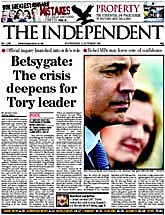
Geneva, Switzerland
info@astonesthrow.ch

One of the most frequently prescribed medicines for fixing a broadsheet newspaper’s declining circulation is to order major surgery – basically cut the patient down to size by turning it into a tabloid. But as with most medicines there are side effects, and one of most frequent is that advertisers won’t pay the same money, let alone more, for a smaller advertising space.
As far as the advertiser is concerned a full page in a tabloid is not the same as a full page in the broadsheet (and that is not just because of size but also because tabloid is not seen as authoritative as broadsheet). As far as a publisher is concerned, a full page is a full page. But there is now enough experience with the tabloid switchover that new medicines are at hand to help alleviate the problem.
It was not a problem that publishers first thought they would have. When the Independent in the UK switched to tabloid it was an immediate circulation success. But advertisers balked at paying the same rate card as they had done for the broadsheet. The end result is that the Independent says that it will take an extra year to reach the business plan figures it had counted on when planning the switchover. One reason The Times took so long to complete its switch to “compact” is that when it was publishing both broadsheet and tabloid issues, advertisers flatly refused to pay the same rate card for the tabloid.
Recently published surveys by McKinsey and by the International Newspaper Marketing Association (INMA) point out that most newspapers that switch to tabloid see a drop in advertising revenue. Advertisers simply won’t pay the same for what they perceive to be less and a newspaper needs to change its rate card methodology.
An interesting
case study is Blick in Switzerland. A broadsheet, it wa s
the circulation leader for many years. And then came along the upstart 20
Minutes free tabloid aimed the young commuter and within three years Blick
had lost its circulation throne – 20 Minutes was the number one
circulation newspaper in Switzerland.
s
the circulation leader for many years. And then came along the upstart 20
Minutes free tabloid aimed the young commuter and within three years Blick
had lost its circulation throne – 20 Minutes was the number one
circulation newspaper in Switzerland.
Blick, owned by Ringier, Switzerland’s most powerful publishing house saw the writing on the wall and decided, basically, “If you can’t fight them, join them” It was time to turn tabloid.And the plan they put forward to do it basically worked.
For a start, it, too, printed the broadsheet and compact side-by-side, but unlike the UK newspapers that did it for months, Blick did it for just seven weeks. During that period 75% of its readers chose the tabloid. The market had overwhelmingly made its decision. There was no need to continue longer with both versions.
But the advertising community said it was not willing to pay the same for equally proportioned space in the tabloid as it was paying in the broadsheet. So Blick altered its advertising rates.
It reduced the price of the full-page ad by 10%, but it raised the price of smaller sized ads because, given the new format, they were now more visible. The rates were guaranteed for 18 months.
Management now claims that within months of the
changeover, the advertising revenue for the tabloid surpasses the
broadsheet.
The switchover also had an effect on circulation. During the side-by-side trial circulation actually grew by about 5%, but once it was the tabloid by itself circulation fell to about the same as the broadsheet, except subscriptions were lost but the numbers were made up at the kiosk.
The fall in subscriptions is in line with the McKinsey survey which reported that the it was normal for the subscriber base to fall between 3-5% as some people react negatively to the new paper size and either go to a competitor or decide to do without a newspaper.
Switching to tabloid has also affected the editorial product. The new Blick appeals to younger readers and also more women are reading it than when it was a broadsheet – both developments said to be very common in a switchover according to McKinsey. Editorial has reacted by providing more information that interests those demographics.
Among the changes a newspaper can expect in switching to tabloid, according to the McKinsey and INMA research:
Circulation: Likely to stop any major ongoing decline, but growth will not likely top 8%. There are exceptions – The Independent saw circulation increase 18% within six months of its switch -- but that was the exception rather than the rule.
Costs: Expect few savings. While newsprint consumption may decrease printing and distribution costs are likely to remain the same. McKinsey goes as far to say that even if there are savings it will be less than the advertising losses one should expect.
Advertising: Advertisers will not buy into using a broadsheet rate card for a tabloid. They want lower rates. INMA suggests the way around this is to shift from space-based pricing to modular pricing -- matching price to impact -- as used in magazines.
Market Share: INMA estimates that in 10 of 12 competitive markets where the switch was made, the new tabloid gained market share at the expense of the remaining broadsheets. And being the first in the market to make the switch – such as the Independent – appears to be a definite advantage.
The bottom line is that in those markets where a broadsheet is losing out to a free tabloid, making the switch can help the cause but you need to agree rate card philosophy with your advertisers BEFORE making the switch. Fixing things afterwards can be very time-consuming and very expensive.
© Philip M. Stone of Stone & Associates, a partner in followthemedia.com